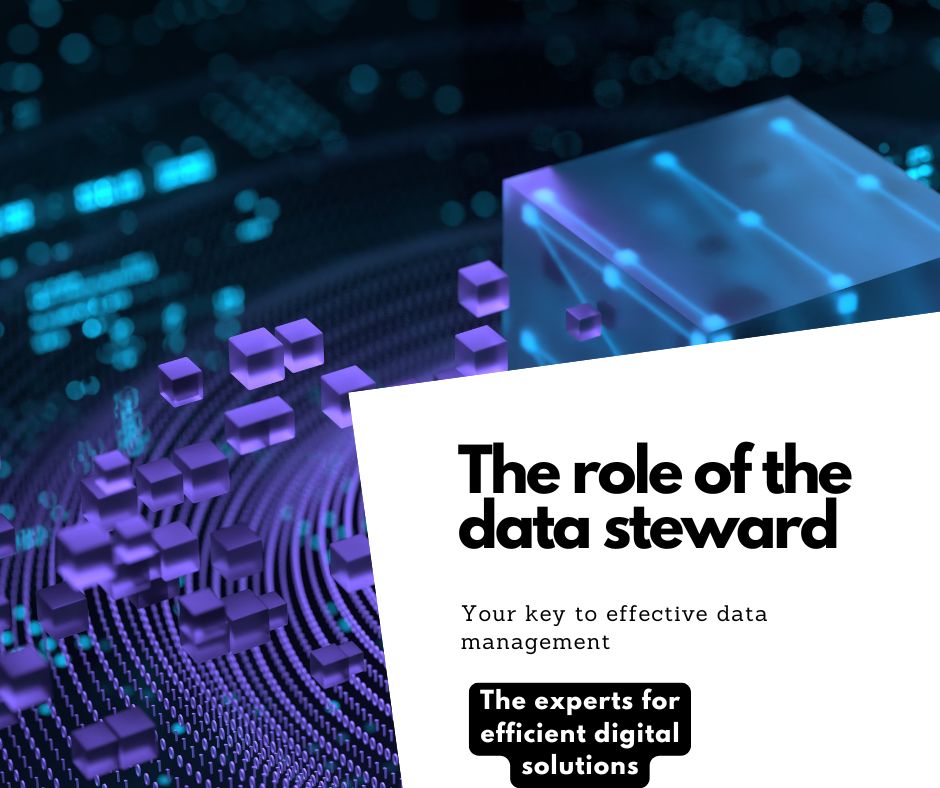The role of the data steward: Your key to effective data management

Companies that use their data effectively can make informed decisions, achieve competitive advantages and increase customer satisfaction. In this context, the data steward plays a key role. As the guardian of data quality and integrity, the data steward ensures that data is not only collected, but also managed and used wisely.
But what exactly does a data steward do? What tasks and responsibilities are associated with this role? In this article, we take a detailed look at the role of the data steward and show how this position helps companies to optimize their data management strategies. We also highlight typical tools that data stewards use and success metrics that make their performance measurable. Using specific real-world case studies, we illustrate how companies can achieve significant improvements in their data management through effective data stewardship.
The tasks of a data steward
The role of the data steward is multifaceted and encompasses various responsibilities aimed at ensuring the quality, integrity and security of data within an organization. Here are the essential tasks of a data steward:

Data quality management
Data stewards are responsible for ensuring data quality. This includes monitoring data for accuracy, completeness, consistency and timeliness. They carry out regular data checks and implement data cleansing processes to identify and rectify errors.
Data integration
Data stewards work to bring together and integrate data from different sources. This requires a deep understanding of the data flows in the company and the ability to harmonize data from different systems in order to obtain a uniform picture of the information.
Training and support
Another important aspect of the role is training employees on how to handle data. Data stewards provide support and training to raise awareness of data management practices and ensure that all team members adhere to the established guidelines.
Monitoring and reporting
Data stewards are also responsible for monitoring data applications and processes. They develop KPIs and metrics to measure data quality and create regular reports to communicate the progress and results of their data management activities.
Documentation of data
An important task is the comprehensive documentation of data sets and their origin. Data stewards create metadata documentation that contains information about the data structure, data sources and data responsibilities. This documentation serves as a reference for other team members and promotes transparency in data management.
Development of data guidelines
Data stewards are often involved in the creation and implementation of data policies and standards. They define how data may be collected, processed and used to ensure that all legal and regulatory requirements are met.
Cooperation with other departments
Data stewards act as a link between different departments that use data. They work closely with IT teams, data analysts and specialist departments to ensure that data requirements and standards are met in all areas of the company.
Risk management
In today’s world, managing data privacy and security risks is critical. Data stewards identify potential risks in the handling of data and develop strategies to minimize these risks, thereby ensuring the security of company data.
By fulfilling these tasks, data stewards play a crucial role in a company’s data strategy and help to ensure that data can be used effectively as a valuable resource.
The relationship between data stewards and master data management
Data stewards and master data management (MDM) are closely linked and play a crucial role in the effective management of company data. While both concepts have different focuses and responsibilities, they complement each other and together contribute to improving data quality and integrity in a company.
Collaboration between data stewards and master data management is of central importance for an effective data strategy. While data stewards focus on the day-to-day management and quality of data, MDM ensures that a consistent, trustworthy and accessible database is available for all areas of the company. Together, they enable companies to make data-based decisions and drive their digital transformation.


Typical tools for the data steward
Data stewards need a variety of tools to perform their tasks effectively and ensure the quality of the data. Here are some of the tools that are often used in practice:
- Data quality tools
- Informatica: This software enables data stewards to profile, cleanse and monitor data to ensure it meets established quality standards.
- Talend: A data integration tool that provides powerful data cleansing and validation capabilities.
- Data management platforms
- Collibra: This platform supports data governance and data management with functions for cataloging data, managing data policies and monitoring data quality.
- Alation: Data catalog software that promotes collaboration between data stewards and other users by simplifying access to and management of data resources.
- Metadata management tools
- Apache Atlas: This tool offers comprehensive metadata management functions that enable data stewards to track the origin and lifecycle of data.
- Microsoft Azure Purview: A cloud-based solution for managing metadata and monitoring data movement in the Azure environment.
- Business Intelligence (BI) Tools
- Tableau: This visualization tool helps data stewards perform data analysis and create relevant reports that illustrate data quality and usage.
- Power BI: Microsoft’s BI tool enables the creation of interactive dashboards and reports to monitor data quality and communicate findings.
- Data integration tools
- Apache NiFi: A tool for automating the flow of data between systems that supports data stewards in the integration of data sources.
- MuleSoft: A comprehensive integration platform that enables data stewards to connect data from different applications and systems.
Using these or similar tools enables data stewards to perform their tasks efficiently, ensure the quality and integrity of the data and have a positive impact on the company’s data strategy.
Success metrics for a data steward
The performance of a data steward can be evaluated using specific success metrics that measure the effectiveness of data management and quality. These metrics are critical to quantifying the data steward’s impact on the organization’s data strategy and driving continuous improvement. Here are some of the key success metrics for a data steward:
By using these success metrics, a data steward can not only evaluate their own performance, but also demonstrate the value of their work to the company. Continuous monitoring of these metrics makes it possible to identify weaknesses and take targeted improvement measures to further optimize data management.


Case study 1: Data management in a financial services company
Background:
A large financial services company was facing considerable challenges in dealing with its customer data. Due to a lack of data quality and inconsistencies in the various systems, there were frequent errors in customer billing and communication. This not only led to customer dissatisfaction, but also to increased support costs.
Solution:
As an external service provider, we supported the company by providing an experienced data steward to optimize data management. They implemented a comprehensive data quality management system that included regular data checks, cleansing and validation. We also introduced a clearly documented process for data maintenance to ensure the consistency of data in different systems. In addition, we organized training for the internal team to ensure that all employees complied with the new policies and procedures.
Result:
Data quality improved significantly within just a few months. The accuracy of customer data rose to over 95% and the number of customer complaints due to data errors fell by 40%. The company was able to increase its efficiency and significantly improve customer satisfaction, which had a positive impact on customer loyalty. Our support as a service provider made a decisive contribution to establishing the data as a valuable resource for strategic decisions.
Case study 2: Personalization in e-commerce
Background:
An international retailer was struggling to consolidate and manage its customer data, which was spread across multiple stores and online channels. This fragmentation led to inaccurate marketing campaigns and inefficient targeting of customers, which ultimately impacted sales.
Solution:
As a service provider, we were hired to help the company overcome these challenges. We hired a data steward who was responsible for monitoring and maintaining the customer data. The data steward implemented a centralized data management system that provided a unified view of customer data. Using modern data integration tools, we consolidated the data from different sources, while clear data guidelines were established to ensure the quality of the information. We also conducted training for employees to raise awareness of the importance of data quality.
Result:
The introduction of the data steward and the central data management system led to a significant improvement in data integrity and utilization. Customer data was now consistent and up-to-date, enabling the marketing team to create targeted campaigns. This resulted in a significant increase in sales within six months and significantly improved customer targeting. Our support as a service provider proved crucial to the success of the company’s data-driven marketing strategy.


The role of the data steward is crucial for companies to ensure the quality and integrity of their data. As a service provider, we pride ourselves on helping companies develop effective data management strategies and utilize their data as a valuable resource. By implementing best practices and cutting-edge tools, we help our clients succeed in the data-driven world.
Till Neitzke
Conclusion: The role of the data steward
The role of the data steward is critical to the success of organizations in today’s data-driven world. By effectively managing data quality, integrity and security, organizations can not only make informed decisions, but also increase their competitiveness. A data steward acts as a bridge between the technical and business aspects of data management, ensuring that all stakeholders view data as a valuable resource and helping to ensure that data is used strategically.
Implementing a data steward program is beneficial for companies of all sizes. The case studies achieved through our services clearly demonstrate how we can help companies optimize their data management strategies and overcome specific challenges. By providing comprehensive analysis, training and modern tools, we help our clients not only organize their data, but also improve the quality and efficiency of their overall business processes.
At a time when data is playing an increasingly important role, investing in effective data stewardship is not only sensible, but necessary to remain successful in a competitive environment.

Successful together in the digital transformation –
Your introductory meeting with DMG
In our introductory meeting we will discuss
- what your current challenges are in digital projects
- how other companies have done it and how you can use this to your advantage.
- what needs to be done now and whether we are the right people for the job.
[ameliastepbooking]
